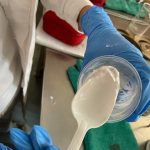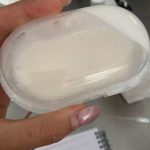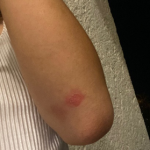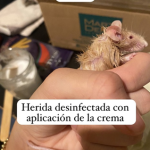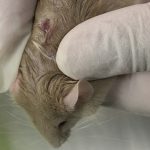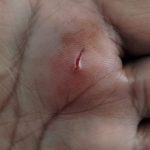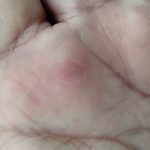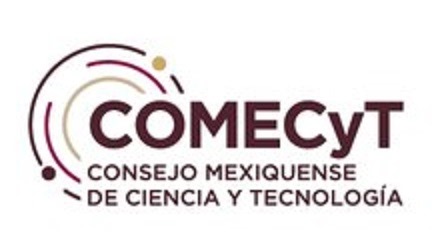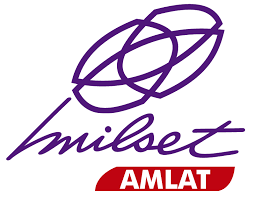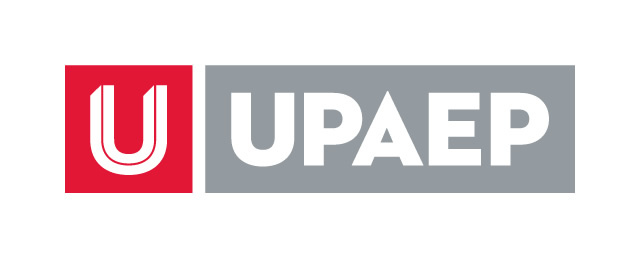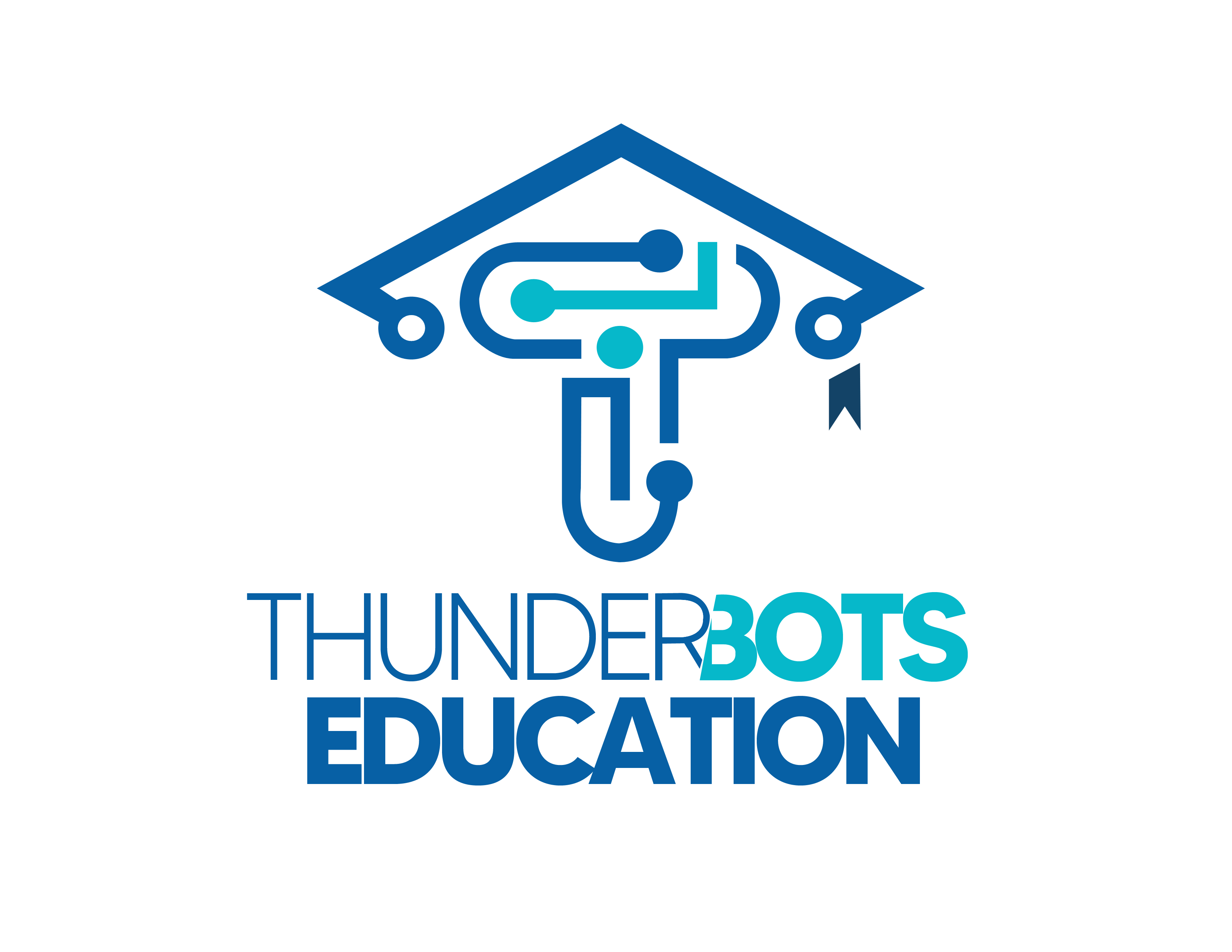PJ – MS – 60 – MA Cream – BAS
PJ – MS – 60 – MA Cream – BAS
Categoría: Pandilla Juvenil (1ro. 2do. y 3ro. de nivel Secundaria)
Área de participación: Medicina y Salud
Resumen
La innovación en el ámbito de la salud ha dado lugar al desarrollo de una crema a base de seda de araña, basada en contribuir en el ODS 3, que se centra en la salud y el bienestar. Dicho producto tiene como propósito acelerar la cicatrización de heridas, aprovechando las propiedades únicas de la seda de araña, como su alta resistencia y capacidad de regeneración. La investigación inicial ha mostrado resultados prometedores: en pruebas realizadas en ratones, tanto en el grupo control como en el grupo de prueba, Cream-BAS demostró una notable eficacia. Los ratones que recibieron la crema mostraron una cicatrización rápida, comparable a los resultados obtenidos en pruebas con humanos.
En estudios posteriores con dos personas de diferentes edades, la crema también ha mostrado resultados satisfactorios. En ambos casos, las heridas se curaron en un rango de 7 a 12 días, evidenciando la efectividad del producto en diversos tipos de piel y condiciones. La crema no sólo acelera el proceso de cicatrización, sino que también mejora la calidad de la recuperación, alineándose con los objetivos del ODS 3 para promover la salud y el bienestar.
Actualmente, el proyecto está en fase de experimentación adicional. Se está desarrollando un desinfectante complementario que se utilizará para limpiar las heridas antes de aplicar la crema. Este desinfectante será crucial para maximizar la eficacia del tratamiento y asegurar que la crema actúe en un entorno óptimo para la cicatrización y como posible tratamiento alternativo para disminuir la cicatriz que se generó tras una lesión.
Pregunta de Investigación
¿Qué efectos tiene la tela de araña en la regeneración y cicatrización de una herida?Planteamiento del Problema
Según la directora de los Centros para el Manejo Avanzado de Heridas en Latinoamérica, las heridas más recurrentes son las lesiones traumáticas (26.6%) esto derivando una gran suma de dinero para dar atención a esta problemática.
Es por ello que retomamos uno de los métodos antiguos para sanar heridas con ayuda de tela de araña, llevándola a un producto de fácil acceso y bajo costo para la población.
Antecedentes
Las propiedades de la tela de araña son particularmente variadas, y sus potenciales aplicaciones tan promisorias, que en la actualidad se realizan numerosas pruebas en distintas partes del mundo para desarrollar diferentes productos partiendo de su composición y características. Es fuerte como el acero, pero al mismo tiempo, muy flexible. Es biodegradable y también biocompatible.
Se contempla la posibilidad de utilizarla en la fabricación de redes, prendas de vestir entre las que se incluyen piezas resistentes a las balas cuerdas, instrumentos musicales y en fibras de vidrio en sensores ópticos, por mencionar solo algunas opciones.
Y el campo médico no es la excepción. Hay laboratorios en importantes universidades y centros de salud dedicados a explorar las aplicaciones de la seda de araña en aspectos relacionados con la salud.
Se están haciendo experimentos con el uso suturas, reparaciones óseas, regeneración de cartílagos e injertos de piel, áreas en las que se utiliza la seda de gusano.
En la mayoría de los casos en los que se plantea su uso, la de araña es mucho mejor que la del gusano, pero es difícil de obtener y de producir en grandes cantidades para que sea viable comercialmente, le dice a BBC Mundo el profesor Fritz Vollrath, director del Grupo de la Seda de la Universidad de Oxford, en Inglaterra.
Objetivo
OBJETIVO GENERAL
Formular una crema a base de tela de araña para acelerar el proceso de cicatrización de una herida superficial.
OBJETIVO PARTICULAR
Desnaturalizar la tela de araña con ayuda de agentes químicos.
Justificación
La piel es uno de los órganos de mayor superficie, compuesta por dermis, epidermis y tejido subcutáneo; cumple funciones esenciales para el organismo, por ejemplo, actúa como barrera, impidiendo el paso de agentes nocivos como microorganismos, radiación, alérgenos, tóxicos, entre otros.
Por otro lado, regula la pérdida de agua, iones y metabolitos. Además, proporciona protección mecánica, protegiendo tejidos internos de traumatismos. Es por esto que la reparación o cicatrización de la piel es fundamental, ya que permite la mantención de estas funciones en el tiempo.
El uso de la tela de araña o seda de araña para la sanar heridas es implementada desde hace ya varios siglos, se cree que, en 1346, los soldados que estaban en servicio del rey francés Felipe VI; en una de las batallas de la guerra de los Cien años llevaban en su botiquín unas cajitas repletas de telarañas para taponar posibles heridas.
Hipótesis
Desnaturalizando las proteínas que se encuentran en la tela de araña podremos obtener las propiedades de esta y utilizarla como principal componente de una crema para poder acelerar el proceso de cicatrización de una herida.
Método (materiales y procedimiento)
Para elaborar 600 gr de crema se utilizaron los siguientes componentes.
| Ingredientes | Precio | Porcentaje |
| Base de crema neutral 1 Kg | $90 | 60 % |
| Telaraña 10 gr | $0 | 10 % |
| Lavanda 5 mL | $1.07 | 16.6 % |
| Urea 5 gr | $2.18 | 13.4 % |
Tabla 1. Porcentajes utilizados para fabricar 600 g de Cream-BAS
Los materiales proporcionados por el laboratorio del Colegio Baden Powell fueron los siguientes: vaso de precipitado de 250 ml, 1000 mL, agitador de vidrio, agitador magnético, reactivo analítico “Urea”, agua destilada, olla de presión.
Procedimiento
Se recolectaron 10 gramos de tela de araña, la cual fue sometida a limpieza con agua destilada para eliminar agentes ajenos a ella como tierra, huevecillos de araña, insectos atrapados, etc.
Una vez limpia se colocó en la olla de presión para esterilizarla por 45 minutos para asegurar de que se eliminaran bacterias que pudiera tener.
Posteriormente se prepara una solución de Urea 1:1 para poder dejarla reposando por al menos 24 horas en agitación constante para poder obtener las proteínas de la tela de araña.
Una vez transcurrido este tiempo se tomó aproximadamente 5mL de la solución para poder colocarla a la base de crema, se agitó hasta obtener una mezcla homogénea. Posterior a esto se colocaron 5ml de lavanda para dar un aroma agradable.
Galería Método
Resultados
Para poder realizar nuestra crema a base de telaraña, se tuvieron que realizar varias pruebas para lograr que se forme la consistencia que queríamos, las primeras pruebas que hicimos la telaraña, no se disolvió totalmente en la crema, no se obtuvo el resultado que esperábamos, hasta varias pruebas después, la segunda prueba que hicimos preferimos utilizar el agua de la telaraña bien desinfectada y poner 1 ml de esa agua a la crema y así poderla utilizar para ver si funcionaba, asimismo, en otras pruebas nuestra crema tenía una consistencia muy líquida o muy espesa, al igual que con un olor muy diferente al que nosotros queríamos, por eso estuvimos experimentando con varios productos y materiales para así poder concluir nuestra crema. (anexo …)
Tras obtener la crema con la consistencia que se deseaba, buscamos personas que tuvieran heridas recientes para corroborar que la crema servía.
Cream – Bas dio resultados satisfactorios de los 3 ensayos que se realizaron.
Ensayo 1.
La paciente tenía una herida considerada como quemadura ya que ella práctica voleibol y su herida fue causada tras una caída jugando; ella ya empezaba a generar costra y se la retiro para colocarse la crema, por lo que su tiempo de sanación fue posterior a los otros ensayos.
Ensayo 2.
Tras los resultados fallidos del primer ensayo y por el tiempo se decidió realizar el ensayo en dos ratones acomys donde se tuvieron resultados satisfactorios, a ambos se le realizaron incisiones cutáneas apropiadamente de 1.5 cm, observando que cream – BAS aceleró la curación en un 30% a comparación del grupo control.
Ensayo 3.
Una vez probada la crema en los ratones se probó en una persona que contaba con una incisión en la palma de la mano, se colocó la crema demostró una tasa de curación significativamente mayor (40%) en comparación con el tratamiento convencional.
El paciente comenta que pasado un tiempo (aproximadamente 5 – 10 minutos) tras colocar cream – BAS sintió un estiramiento en la herida.
Por último, la herida con cream – BAS no genero costra por lo tanto no se generó cicatriz.
Discusión
Los resultados del estudio sugieren que la crema hecha con tela de araña puede ser efectiva para acelerar la curación de heridas. En los ensayos 2 y 3 mostraron resultados significativos en comparación con los controles. Sin embargo, el ensayo 1 fue inválido debido a la costra preexistente en la herida del participante.
La media del tiempo de curación en los ensayos 1 fue de 7 días en el grupo de tratamiento vs. 10 días en el grupo control.
Conclusiones
La crema hecha con tela de araña muestra potencial en la curación de heridas, pero se necesitan más estudios para confirmar estos hallazgos y establecer su eficacia y seguridad en diferentes contextos clínicos.
Bibliografía
https://blog.nutritienda.com/serina/
https://laboratoriosorel.com/aminoacidos-b eneficios-para-la-piel/
https://www.medfinis.cl/img/manuales/Cla sificacion%20heridasv2020.pdf
http://www.scielo.org.co/pdf/rfmun/v61n4/v61n4a14.pdf
https://www.revespcardiol.org/es-pdf-1311 3924
https://www.elmostrador.cl/agenda-pais/vi da-en-linea/2017/01/06/tres-sorprendentes-usos-medicos-de-la-seda-de-telarana/#:~:text=Las%20propiedades%20antibacterianas%20que%20tiene,Biol%C3%B3gica%20se%20refiere%20a%20ellas
PJ – MS – 60 – MA Cream – BAS
PJ – MS – 60 – MA Cream – BAS
Summary
Innovation in the field of health has led to the development of a spider silk-based cream, based on contributing to SDG 3, which focuses on health and well-being. The purpose of this product is to accelerate wound healing, taking advantage of the unique properties of spider silk, such as its high resistance and regeneration capacity. Initial research has shown promising results: in tests carried out on mice, both in the control group and in the test group, Cream-BAS demonstrated remarkable effectiveness. The mice that received the cream showed rapid healing, comparable to the results obtained in human tests.
In subsequent studies with two people of different ages, the cream has also shown satisfactory results. In both cases, the wounds healed in a range of 7 to 12 days, evidencing the effectiveness of the product on various skin types and conditions. The cream not only accelerates the healing process, but also improves the quality of recovery, aligning with SDG 3 goals to promote health and well-being.
The project is currently undergoing further experimentation. A complementary disinfectant is being developed that will be used to clean wounds before applying the cream. This disinfectant will be crucial to maximize the effectiveness of the treatment and ensure that the cream acts in an optimal environment for healing and as a possible alternative treatment to reduce the scar generated after an injury.
Research Question
What effects does spider web have on wound regeneration and healing?Problem approach
According to the director of the Centers for Advanced Wound Management in Latin America, the most recurrent wounds are traumatic injuries (26.6%), which means that a large sum of money is spent on addressing this problem.
That is why we have taken up one of the old methods for healing wounds with the help of spider webs, bringing it to a product that is easily accessible and inexpensive for the population.
Background
The properties of spider silk are particularly varied, and its potential applications so promising, that numerous tests are currently being carried out in different parts of the world to develop different products based on its composition and characteristics. It is strong as steel, but at the same time, very flexible. It is biodegradable and also biocompatible.
The possibility of using it in the manufacture of nets, clothing including bullet-resistant pieces, ropes, musical instruments and in glass fibers in optical sensors is being considered, to mention just a few options.
And the medical field is no exception. There are laboratories in important universities and health centers dedicated to exploring the applications of spider silk in aspects related to health.
Experiments are being done with the use of sutures, bone repairs, cartilage regeneration and skin grafts, areas in which worm silk is used.
In most cases where it is being considered for use, spider silk is much better than worm silk, but it is difficult to obtain and produce in large quantities to make it commercially viable, Professor Fritz Vollrath, director of the Silk Group at the University of Oxford in England, told BBC Mundo.
Objective
GENERAL OBJECTIVE
To formulate a cream based on spider web to accelerate the healing process of a superficial wound.
PARTICULAR OBJECTIVE
To denature the spider web with the help of chemical agents.
Justification
The skin is one of the largest organs, composed of the dermis, epidermis and subcutaneous tissue; it performs essential functions for the body, for example, it acts as a barrier, preventing the passage of harmful agents such as microorganisms, radiation, allergens, toxins, among others.
On the other hand, it regulates the loss of water, ions and metabolites. In addition, it provides mechanical protection, protecting internal tissues from trauma. This is why the repair or healing of the skin is essential, since it allows the maintenance of these functions over time.
The use of spider web or spider silk to heal wounds has been implemented for several centuries. It is believed that, in 1346, the soldiers who were in service of the French king Philip VI; in one of the battles of the Hundred Years’ War, carried in their first aid kit some boxes full of spider webs to plug possible wounds.
Hypothesis
By denaturing the proteins found in spider webs, we can obtain their properties and use them as the main component of a cream to accelerate the healing process of a wound.
Method (materials and procedure)
The following components were used to make 600 g of cream.
| Ingredients | Prece | Porcentage |
| Neutral cream base 1 Kg | $90 | 60 % |
| Spider web 10 gr | $0 | 10 % |
| Lavander
5 mL |
$1.07 | 16.6 % |
| Urea 5 gr | $2.18 | 13.4 % |
Table 1. Percentages used to make 600 g of Cream-BAS
The materials provided by the Baden Powell College laboratory were the following: 250 ml beaker, 1000 mL, glass stirrer, magnetic stirrer, analytical reagent “Urea”, distilled water, pressure cooker.
Procedure
10 grams of spider web were collected, which was subjected to cleaning with distilled water to eliminate foreign agents such as soil, spider eggs, trapped insects, etc.
Once clean, it was placed in the pressure cooker to sterilize it for 45 minutes to ensure that any bacteria it might have were eliminated.
A 1:1 Urea solution was then prepared and left to rest for at least 24 hours with constant agitation to obtain the proteins from the spider web.
After this time, approximately 5 mL of the solution was taken to be placed in the cream base, and it was stirred until a homogeneous mixture was obtained. After this, 5 mL of lavender was added to give a pleasant aroma.
Method Gallery
Results
In order to make our spider web-based cream, several tests had to be carried out to achieve the consistency we wanted. The first tests we did, the spider web did not completely dissolve in the cream, we did not get the result we expected until several tests later. The second test we did, we preferred to use the water from the spider web, well disinfected, and put 1 ml of that water in the cream so we could use it to see if it worked. Also, in other tests, our cream had a very liquid or very thick consistency, as well as a very different smell than we wanted, so we were experimenting with various products and materials to be able to finish our cream.
After obtaining the cream with the desired consistency, we looked for people who had recent wounds to corroborate that the cream worked.
Cream – Bas gave satisfactory results from the 3 tests that were carried out.
Test 1.
The patient had a wound considered to be a burn since she plays volleyball and her wound was caused after a fall while playing; She was already starting to form a scab and she removed it to apply the cream, so her healing time was later than the other trials.
Test 2.
After the failed results of the first trial and due to time constraints, it was decided to carry out the trial on two acomys mice where satisfactory results were obtained. Both were given appropriate 1.5 cm skin incisions, observing that cream – BAS accelerated healing by 30% compared to the control group.
Test 3.
Once the cream was tested on the mice, it was tested on a person who had an incision in the palm of the hand. The cream was applied and showed a significantly higher healing rate (40%) compared to conventional treatment.
The patient comments that after a while (approximately 5 – 10 minutes) after applying cream – BAS he felt a stretch in the wound.
Finally, the wound with cream – BAS did not form a scab, therefore no scar was generated.
Results Gallery
Discussion
The results of the study suggest that spider web cream may be effective in accelerating wound healing. Trials 2 and 3 showed significant results compared to controls. However, Trial 1 was invalid due to pre-existing scab on the participant’s wound.
The mean healing time in Trial 1 was 7 days in the treatment group vs. 10 days in the control group.
Conclusions
Spider web cream shows potential in wound healing, but further studies are needed to confirm these findings and establish its efficacy and safety in different clinical settings.
Bibliography
https://blog.nutritienda.com/serina/
https://laboratoriosorel.com/aminoacidos-b eneficios-para-la-piel/
https://www.medfinis.cl/img/manuales/Cla sificacion%20heridasv2020.pdf
http://www.scielo.org.co/pdf/rfmun/v61n4/v61n4a14.pdf
https://www.revespcardiol.org/es-pdf-1311 3924
https://www.elmostrador.cl/agenda-pais/vi da-en-linea/2017/01/06/tres-sorprendentes-usos-medicos-de-la-seda-de-telarana/#:~:text=Las%20propiedades%20antibacterianas%20que%20tiene,Biol%C3%B3gica%20se%20refiere%20a%20ellas



